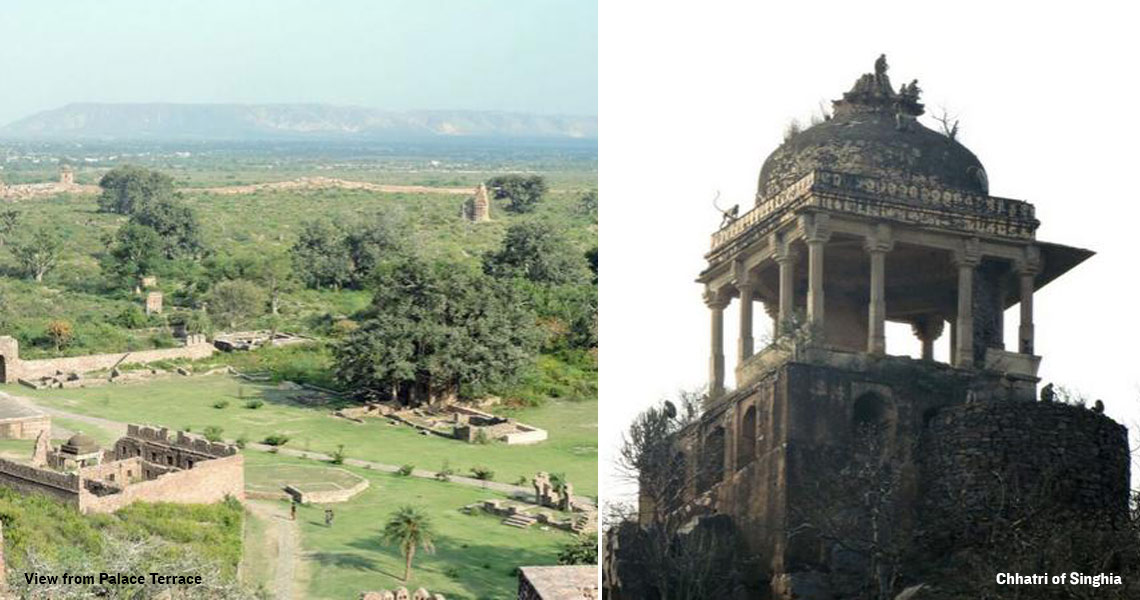Nature’s Playground – Sariska, Part III
In the third part of the exclusive series, traveler Shireen Bharucha takes us on a historical ride and unfolds the quaint mysteries and myths of Sariska.
Sariska dates back to the stone-age with a mix of history, mythology and wildlife. We now make our way to mythological Pandupol, so named because it is believed that the Pandavas spent sometime of their exile period here. In Sanskrit ‘pol’ means a gateway.
Mentioned in the Mahabharata, the Hanuman temple at Pandupol is one of India’s oldest pilgrim destinations. Nobody knows who created the first idol of lord Hanuman, but according to Vyasa, author of the Mahabharata, the Pandava brothers travel through the dense jungles of Sariska to reach the Matsya kingdom, ruled by their ally, king Virata. On their journey a mountain blocks their way. The strongest of the brothers, Bhima uses his mace and smashes a passage through the mountain releasing a hidden spring in the process. This incredible display of strength fills Bhima with pride, so Hanuman, Bhima’s immortal half brother teaches him a lesson in humility. Appearing as a frail old monkey, he obstructs the passage by lying across it in a supine position. In spite of repeated requests he refuses to budge. Bhima tries to scare him off by boasting about his strength. Hanuman tells Bhima to move his tail and make a path. Bhima tries hard but fails and realizes that he is dealing with no ordinary monkey. Humbled, the Pandavas ask the old monkey to reveal his identity. Hanuman does so and blesses all the brothers. In return, Hanuman instructs them to build a temple at the spot of the encounter. The idol of Hanuman within the newly constructed, simple, pink coloured temple lies in the same position as narrated by Vyasa.

Hanuman Temple at Sariska | Ruins of Johari Bazaar Bhangarh Fort Sariska
Fact is that Pandupol is a natural arch created by the action of water on limestone. The temple was built 5000 years ago by Hanuman’s devotee, Sant Nirbhaya Dassji Maharaj. A visit to this temple brings an end to our safari.
Kankwari Fort, built by Maharajah Jai Singh II of Jaipur in the 17th century is famous because the Mughal Emperor, Aurangzeb, imprisoned his brother, the scholarly and secular Dara Shikoh here, before executing him. This fort within the tiger reserve was a major tourist attraction. However in December 2010, the then Environment and Forests Minister, Jairam Ramesh, took strong exception to people visiting the fort as it is in the forest’s core area. Hence this fort is no longer open for public viewing.
However there is the less explored Bhangarh Fort located at the border of the Sariska Reserve, which we visit in the afternoon, accompanied by Mr. Sarkar. The drive supposed to take an hour and a half from Tiger Heaven stretches to over a painful two hours on an unpaved, bumpy and narrow road which winds its way through local villages. There is no signage anywhere so we stop to ask the locals for directions.
This deserted fort city, called ‘bhootbangla’ or the ‘house of ghosts’ is in absolute ruins. It is reputed to be the most haunted place in India and one of the most haunted places in the world. According to information provided by the Archaeological Survey of India, this ancient township was founded in the latter half of the 16th century AD by Raja Bhagwant Das, the ruler of Amber. Later Madho Singh, who was a diwan (minister) in the court of the Mughal Emperor (AD 1556-1605) and the brother of Raja Man Singh, made Bhangarh his capital. The ruins consist of fort walls, gateways, markets, havelis (mansions), chhatris (dome shaped pavilions), several temples built in the Nagara style, the palace and a tomb. The township was protected by successive fortifications – the outermost had five gateways from north to south – Ajmeri, Lahori, Hanuman, Phoolbari and Delhi Gate.
Historical archives suggest that Bhangarh once was a thriving township of more than 10,000 residents. Some historians believe that Bhangharh was inhabited for centuries before it became a royal city. The new village of Bhanghar hosts a mere 200 households with a population of 1500. There are no historical records giving reasons for the city being deserted overnight. Bhanghar has little history, but plenty of mystery surrounding it, hence two different myths are cited.
Myth 1: A monk named Balu Nath lived alone in the forests of Bhangarh having given up worldly desires so that he could devote his life to God. He was against the city being built as it would be a source of disturbance. After much persuasion by King Bhagwant Das, he relented, on the condition that the shadow of the king’s palace should never touch him or his abode. If that happened, the city would perish. The king agreed and a four storeyed palace was built. Over time the monk’s warning was forgotten and three more storeys were added by Ajab Singh, a later king. The palace’s shadow now touched BaluNath’s residence and the city was doomed. No one knows whether the residents left or they died because of the curse. It is believed that the small samadhi where BaluNath is buried exists in the vicinity of the fort.
Myth 2: This is just one of many versions of this story. Rani Ratnavati was the most beautiful woman in Rajasthan. She had many admirers, including Singhia, a tantric who loved her dearly, but he could not propose marriage to her because of her high birth. One day the princess accompanied by her maids went to the market to buy scented oil. Singhia saw her and cast a spell. He added a love potion to the oil by which Ratnavati would be hypnotized so that he could seduce her. Ratnavati saw what
Singhia did and threw the container of oil away. The container hit a boulder which then rolled and crushed Singhia. As he was dying, he cursed the town of Bhangarh with overnight destruction and death to all the residents. It was shortly after this curse that Bhangarh went to war with neighbouringAjabgarh. Both cities were destroyed and the princess was killed. Though Ajabgarh was rebuilt, Bhanghar remained uninhabited. Moreover, it is said that whenever houses are built, the roofs collapse killing the inmates, hence most houses in the vicinity of the fort have thatched roofs rather than concrete ones.
Another assumption for the city being deserted is the devastating famine of 1783 which forced people to leave their homes in search of food.
Locals say that there have been many suicides and unnatural deaths in the area of the fort. They believe that those who die untimely deaths become ghosts. It is also rumoured that those who stay overnight at the fort do not return, though caretakers of temples within the fort do reside there, even though there is no electricity.
At the entrance to the fort are the ruins of the dancers’ haveli and Johari Bazar, which literally means jewellers’ market. Locals say paranormal activities take place here at night. The sound of music, the tinkling of anklets and blood-curdling shrieks can be heard.
In 2013, as part of NDTV’s Good Time series – India’s Most Haunted – the team of Rocky and Mayur spent the night at the fort armed with sophisticated equipment for ‘ghost sensing’. They felt stones being thrown at them and they heard footsteps, but could not conclude as to whether the place was haunted or not.
The temples in this complex consist of the Hanuman Temple at the gate, Gopinath Temple, Someswar Temple, KeshavRai Temple, Mangla Devi Temple, Ganesh Temple and Naveen Temple.

Keshav Rai Temple | Temple at Bhangarh
The royal palace is located at the farthest end of the fort area, behind large gates, against the backdrop of the mighty Aravilli Range. A few pillars that still stand tell of bygone grandeur with the carvings on them visible. In the debris of the palace, remnants of marble columns are visible, hinting that the palace might have been clad in marble. Standing on the terrace of the palace we view the vast expanse of the fort.

royal palace in sariska tiger heaven | Remnants of pillars with carvings.
The chhatri of Singhia, which is intact, can be seen on the hilltop. Outside the gates of the fort is a tomb presumed to be that of the son of the Sikh King Hari Singh Nalwa (1791-1837). This son converted to Islam. A few other monuments also seem to be intact, but with no trained guide to explain and lack of credible information, people walk around aimlessly. The lush lawns with centuries old banyan trees make for a pleasant picnic spot.

View from Palace Terrace | Chhatri of Singhia
Though Bhanghar has been put on Rajasthan’s tourism map, the fort is in dire need of restoration before it can become a tourist attraction. At present besides the mounds of rubble, troops of rhesus monkeys and a few lungurs have the run of the place until a pack of ferocious dogs chases them away. Peafowls, rock pigeons and other birds are visible, as the fort is situated in a forest area.
A notice by the Archeological Survey of India warns: ‘Entering the borders of Bhangarh before sunrise and after sunset is strictly prohibited’, which is taken as proof that the fort is haunted! Wild animals from the tiger reserve enter the fort premises in the dark, so probably the notice is a warning as a safety precaution.
In part four of this series, the author explores Sterling Holidays – Tiger Heaven, the perfect place to answer the call of the wild. Click here to read Nature’s Playground – Sariska Part IV.
Quick Links
Nature’s Playground – Sariska, Part I
Nature’s Playground – Sariska, Part II
Nature’s Playground – Sariska, Part III
Nature’s Playground – Sariska, Part IV
The views expressed by the author are in her personal capacity.

